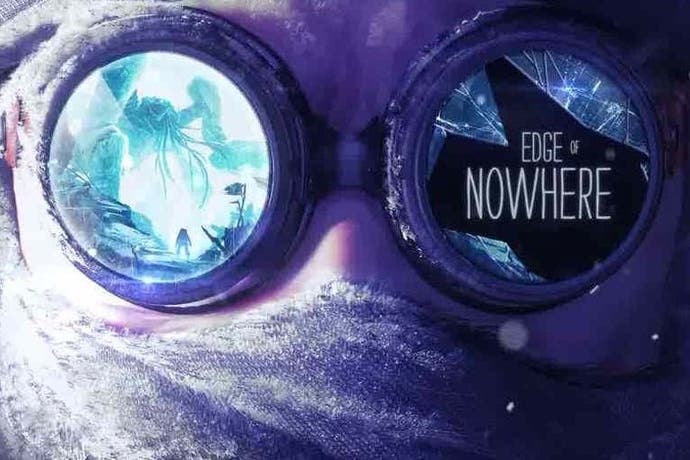Edge of Nowhere review
Cthul runnings.
One of the most exciting powers of VR is the power to make developers see things afresh. Edge of Nowhere is hardly an enormously experimental title - Insomniac's first Oculus outing is a traditional action-horror game about an expedition to the South Pole that goes terribly awry - but I'm not sure the team would have handled the cut-scenes, say, in quite the same manner if they weren't counting on tech that put players right inside the moment. In third-person VR, the player is a camera, and that often means that you feel like an un-named lurker within the game, viewing proceedings from a physical vantage point. Edge of Nowhere opens with something very bad happening in a jungle, yet Insomniac chooses to place you behind a clump of bushes for much of the action. In VR, this strange conceit works beautifully, as it creates a real tension. Something ghastly is unfolding, but the view is blocked. Or is it?
So although Edge of Nowhere's story stays very close to the standard Lovecraftian template, its cut-scenes - and I can't believe I am typing this about cut-scenes - are pretty much unmissable. Even when you aren't parked behind foliage, VR's special abilities with presence are on full display as characters materialise out of the mist around you, taunting you, imploring you, begging you to help - or to stay away. And even when the game itself is in motion, and we're back in standard third-person, your own first-person perspective, tracking the game's stoic, heavy-footed hero through a frozen polar world of caves, sheer drops and collapsing ledges lends a palpable air of vulnerability to proceedings.
Lovecraft was always going to be perfect for VR anyway, and Insomniac's environmental and character artists have done an astonishing job of bringing his dark polar fantasies to life. As the game moves from white-out, snow-swept open air to cramped, shadowy cave interiors and stranger landscapes beyond, there is a real care paid to the little details: the crunch of snow underfoot, the creak and grind of ancient stones shifting overhead. Ice gets special treatment: thick green spars of the stuff webbed with age-old fissures, scalable walls emitting a soft glow from within and spidering with cracks as it threatens to give way.
And, as this is Lovecraft, Antarctica is home to more unlikely substances, too: fantastical architecture, luridly coloured and covered in anything from throbbing pustules to - eek! - golden feathers, dream spaces in which the past takes shape impossibly from the darkest confines of a frozen cave. Insomniac is very good at keeping you moving - no collectables to worry about save the odd audio diary, no alternate paths to sap your dogged forward momentum - but it still leads you past some incredible vistas, and the animation, from the weighed-down plod of the protagonist, surprisingly spry when jumping from ledge to ledge, goggles rendered white and unreadable by snow, to the skitterings and burpings of the increasingly horrid foes you're pitted against, show the same level of craftsmanship as the world they inhabit.
Insomniac is known for this kind of care, of course, and although there is little here that hasn't been a staple of horror games for the best part of a decade now, there's still a clarity of approach that makes the most of the Edge of Nowhere's handful of moving parts. The action is split, fairly neatly, between climbing ice walls, navigating collapsing landscapes, often at speed, and working your way through combat zones where ammo rationing and enemy design tilts you heavily towards stealth. Climbing is straight-up aim-and-move with a bit of jumping, enlivened by the switch from normal rock surfaces to ice, which requires the use of an axe - and which can also drop away beneath you if it starts to crumble, forcing you to take risks as you fling yourself from one surface to another.
The combat, meanwhile, sees you thwacking monsters with that same axe, or blasting them into wonderfully sticky sprays of claret with a shotgun. Aiming is handled by squeezing the left trigger and moving a reticle about as you physically look around with your head (the same counts for the beam of your headlamp in dark areas). Ammo is hard to come by, but most of your enemies are practically blind, navigating by sound alone until you're right on top of them. Levels reflect this elegantly, filled with scatterings of low cover and littered with rocks you can lob about to create distractions. Best of all is local fauna: hulking garlic bulbs that send out spikes when someone ventures too close. Throw a rock to lure the big guys - the lumpen crab thing with the soft back, the gape-chested tendril face, the towering blind peacock - into these and then trigger the spikes with another rock and the animation that ensues is its own reward.
Mixing up these basic elements is a thickening plot and the occasional shift in focus: a prolonged nod to the Arkham Batman games that features a giant dust mite, a third-act detour to a very different location. It's enough to make a short game that's mechanically fairly thin on actual surprises feel rich and even luxurious.
All told, then, Edge of Nowhere is a nice piece of fairly standard design elevated by gorgeous art and canny use of its platform. It's an Insomniac game, in other words, and a pretty wonderful one at that.



